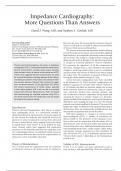ImpedanceCardiography:
MoreQuestionsThanAnswers
DavidJ.Wang,MD,andStephenS.Gottlieb,MD
Correspondingauthor bloodintheaorta.Bymeasuringthisresistance(imped-
StephenS.Gottlieb,MD
ance)itisfeltthatitispossibletoobtainmeasurements
DivisionofCardiology,UniversityofMarylandSchoolofMedicine,
22S.GreeneStreet,Baltimore,MD21201,USA. ofthoracicfluidstatusandbloodflow.
E-mail:sgottlie@medicine.umaryland.edu Theprocessofdeterminingimpedanceinvolvesplacing
CurrentHeartFailureReports2006,3:107–113 severalelectrodesonthethoraxandneckandthenapplying
CurrentScienceInc.ISSN1545-9530 high-frequency,low-amplitudealternatingcurrentthrough
Copyright©2006byCurrentScienceInc. theelectrodes.Thechangeinvoltagebetweensensingand
deliveringelectrodesisthoughttobedirectlyproportional
to changes in measured impedance. Thoracic impedance
Thoracicelectricalbioimpedance,alsoknownasimpedance (Z0) represents the impedance of all the components of
cardiography(ICG),isanoninvasivemethodtoobtainhemo- thethorax.ChangesfromZ0,then,shouldbetheresultof
dynamicmeasurements,includingcardiacoutput.Recently, changesinbothlungvolumes(dueinparttoventilation)
therehasbeenaflurryofreportsontheclinicaluseofICG. andthevolumeandvelocityofbloodinthethoraxduring
AuthorshavesuggestedthatICGmeasurementsareuseful thecardiaccycle.Therespiratorycomponentisfilteredout,
foramyriadofsituations,includingdiagnosisofheartfailure, leavingthecardiac-inducedchangeinZ[1•].
monitoringofapatient’sclinicalstatus,andassistinginmedi- Several electrode configurations have been described
cinetitrationdecisions.However,datacontinuetosuggest in the literature [2–5]. These electrode configurations are
poorcorrelationbetweencurrentgenerationICGdevices linkedtoequationstocalculatestrokevolume.Kubiceket
and invasive measurements of cardiac output, especially al. [3] initially described an equation taking into account
inheartfailurepatients.ICGisalsonotabletoaccurately blood resistivity (based on hematocrit), thoracic imped-
measureleftventricularfillingpressures.Therearelimited ance, ventricular ejection time, electrode distance, and
data demonstrating any improved outcomes using ICG in rateofreductionofthoracicimpedanceduringsystoleand
theclinicalsetting.Giventheavailabledata,ICGuseshould assumingthethoraxisacylinder.Srameketal.[6]subse-
belimitedtotheresearchsetting. quentlymodifiedthisequationbyremovingthehematocrit
dependenceandchangingtheshapetoacone.TheSramek
equationwasfurthermodifiedbyBernstein[7]tocorrectfor
heightandweight.Inadditiontotheequationsdescribedin
Introduction
theliterature,therearecommerciallyavailabledevicesthat
Thoracic electrical bioimpedance, also known as imped-
useproprietaryequationsthatarenotdescribed.
ance cardiography (ICG), is a noninvasive method to
Withtheseequations,Z0,changeinZ,andthesurface
obtainhemodynamicmeasurements.Ithasbeenapproved
electrocardiogram (ECG), a number of parameters are
by the Centers for Medicare and Medicaid Services for
derived (Table 1). The derivative of the impedance wave-
payment in some circumstances and has been advocated
formisthenusedinconjunctionwiththesurfaceECGto
foruseinmanydiseasestates,rangingfromheartfailure
determine the onset of electrical systole and opening and
to hypertension. Some believe it can be helpful for diag-
closureoftheaorticvalve.Additionalhemodynamicparam-
nosis, whereas others have suggested that medication
eters(includingstrokeindex,cardiacoutput,cardiacindex,
titrationscanbeoptimallyperformedbyusingdatafrom
and systemic vascular resistance) are then calculated. Of
ICGmethodology.Reviewofpublishedstudies,however,
note,theinverseofZ0(1/Z0)issometimesreportedasthe
demonstratesthatmoredataneedtobeacquiredbeforeits
“thoracic fluid content,” depending on the bioimpedance
clinicalusecanbereasonablyadvocated.
systeminuse.
TheoryofBioimpedance ValidityofICGMeasurements
ICG is based upon the supposition that the resistance If ICG is to be useful, one must understand its preci-
to electrical current in the thorax varies in relation to sion, accuracy, and reproducibility. Both the validity of
, 108 Neuroendocrine, Vascular, and Metabolic Factors in Heart Failure
Table1.Primaryimpedancecardiography et al. [15•] are similar to those reported for a different
parameters commercialdevice(r=0.596forcardiacoutput)[16].
The best data come from a well-controlled multi-
Changeinvoltagebetweensensing
Z0 anddeliveringelectrodesatbaseline centeranalysisthatwasperformedaspartoftheESCAPE
trial [17•]. Interestingly, despite the apparent gains in
Pre-ejection ElectrocardiographicQwavetoaortic
period(PEP) valveopening the improvement of ICG technology though the late
1990s, the most recent data from the ESCAPE substudy
Leftventricularejec- Aorticvalveopeningtoclosure (bioimpedancegroup[BIG])againshowsquitepoorcor-
tiontime(LVET)
relation(r=0.411forcardiacoutput).
Systolictimeratio PEP/LVET Although the data for ICG-measured cardiac output
and index are variable, with some data suggesting cor-
the absolute numbers and the ability to reflect changes relation with thermodilution and Fick measurements,
inthosenumbersareimportant.Unfortunately,thereare therearecleardatathatthoracicfluidcontent(TFC)bears
many questions still remaining about the values which no relationship to pulmonary capillary wedge pressure
areobtainedbyICG. (PCWP) [15•,16,17•]. The lack of correlation between
Raaijmakers et al. [8•] published a meta-analysis in TFCwithPCWPinBIGdemonstratedanrvalueofonly
1999of112studiescomparingmeasurementsofcardiac 0.177.Inaslightlydifferentmethodofanalysis,Albertet
output by ICG with thermodilution and indirect Fick. al.[14]reportstatisticallysignificant,butclinicallyques-
They report an overall r2 of 0.67. However, this analysis tionable, correlation between quartiles of thoracic fluid
includes many studies with repeated values from the andpulmonarycapillarywedgepressures;thecorrelation
same patient. Indeed, the r2 for single-measurement of thoracic fluid content and PCWP (as separated into
designs (a minority of the studies) was only 0.53. The hypovolemia, normal volume, moderate hypervolemia,
valueswereevenworseincardiacpatients,withanr2 of and severe hypervolemia groups) was limited (r = 0.39;
only0.59,and0.44inrepeated-measurementandsingle- P=0.02).Thelackofcorrelationislikelyduetoseveral
measurementdesigns,respectively. reasons, including body geometry and other causes of
Some studies with commercially available devices increasedthoracicfluidsuchaspleuraleffusionandnon-
have demonstrated better correlations between cardiac cardiogenicpulmonaryedema.
outputandbioimpedance.VandeWateretal.[9]reported Thereareseveralfactorsthatcanaffecttheresultsof
good correlation between cardiac output measured by ICG measurements. It has been demonstrated that lead
thermodilutionandbyICGinarepeated-measuredesign position can significantly affect measurements in both
ofpostoperativepatients(r=0.811,r2=0.658,95%agree- healthyandcriticallyillpatients[4,18].Obesitycanalso
ment –2.36–1.99 L/min). Similarly, Sageman et al. [10] affecttheresultsofICGmeasurements;twostudieshave
reported close correlation in a similar group of patients reported reduced correlation of cardiac output or stroke
after cardiac surgery (Lin’s concordance 0.99, bias 0.07 volume in obese patients. Use of the Sramek-Bernstein
L/min/m2, and precision of 0.40 L/min/m2). Similar methodappearstodecreasetheaccuracy,possiblyowing
results have been reported by other groups in popula- toitsweight-basedassumptionsofbodygeometry[2,19].
tions, including medical ICU patients, traumatic shock,
andmixedmedicalandsurgicalICUpatients[11–13]. Themajorityofthesestudiesarecarefultonotethat
The data for heart failure patients, however, have all hemodynamic measurements were performed by
generallynotdemonstratedclosecorrelationswithother specificexperiencedstaff,withonestudynotingthatelec-
cardiac output determinations. These studies raise some trodesforICGmeasurementswereplacedwithin1cmof
questionsregardingtheuseofICGinpatientswithheart the ideal location as measured by calipers. The issue of
failure. Although Albert et al. [14] reported a correla- locationofelectrodeplacementisimportantasprevious
tion(ρ)of0.89and0.82forcardiacoutputasmeasured findingsdemonstratethatsmalldifferencesinleadplace-
by ICG versus Fick and thermodilution, respectively, ment can lead to markedly different measurements [4].
Drazneretal.[15•]reportedlessrobustrvaluesof0.76 Given the importance of lead placement demonstrated
versus thermodilution and 0.73 versus Fick for cardiac inthesestudies,theaccuracyandreproducibilityofICG
output.Thecorrelationwithcardiacindexwasonly0.64 measurements would need to be validated in the real
and0.61.Evenmoredisappointingly,theauthorsreport worldsetting,asperformedbynonresearchpersonal.
that for an ICG cardiac index less than or equal to The correlation of changes in ICG measures with
2.2L/min/m2,thesensitivityandspecificityfordetecting changesinotherparametershasbeeninfrequentlystudied.
a thermodilution cardiac index of less than or equal to Thesecomparisonshavealsobeenmadewithnonspecific
2.2 L/min/m2 was a dismal 62% and 79%, respectively. parameterswithlimitedutilityForexample,Camposetal.
Similarly,fordetectionofaFickcardiacindexoflessthan [20] reported improvements in multiple echo measure-
or equal to 2.2 L/min/m2, the sensitivity and specificity mentsandICGmeasurementsafter1weekofoptimized
was56%and80%,respectively.ThefindingsofDrazner care for decompensated heart failure. Similarly, Parrott et al.




